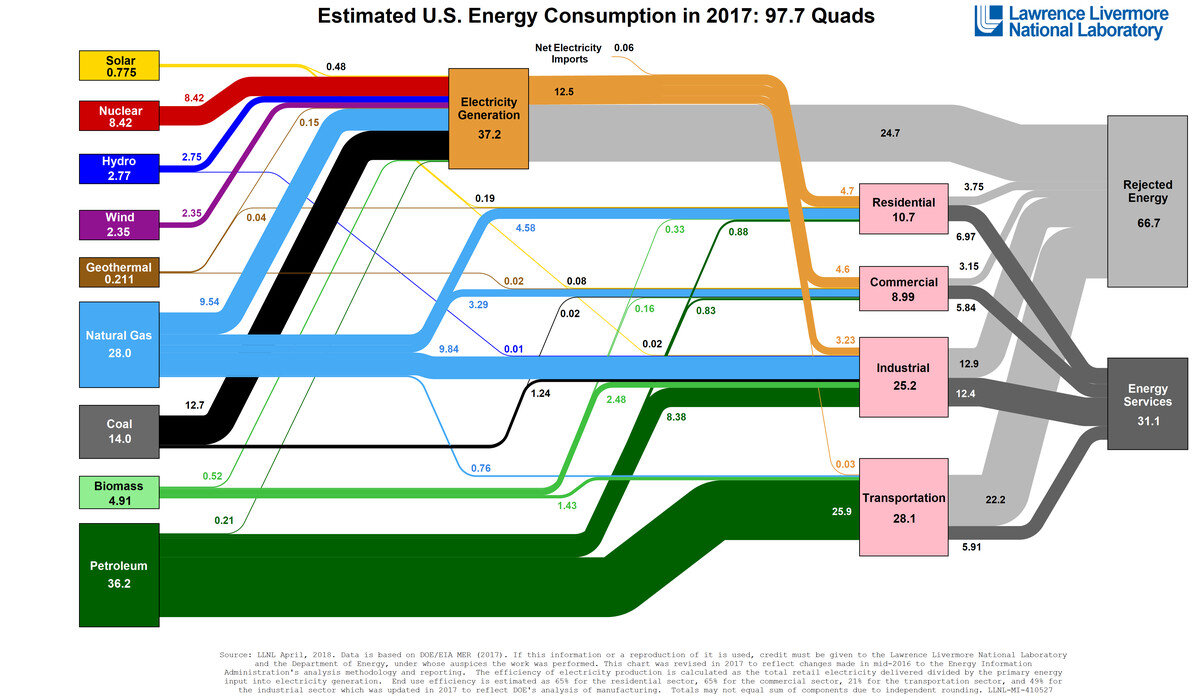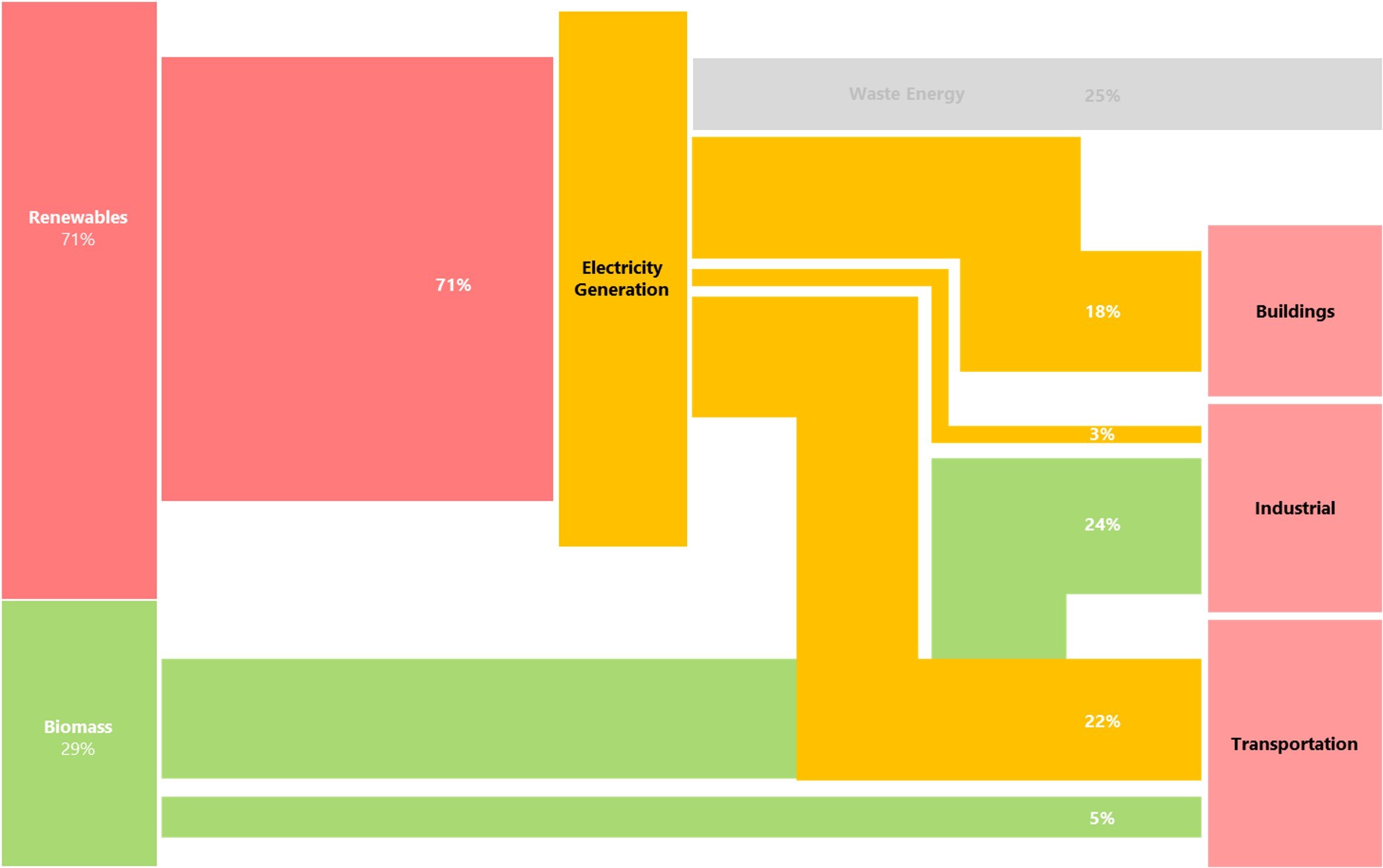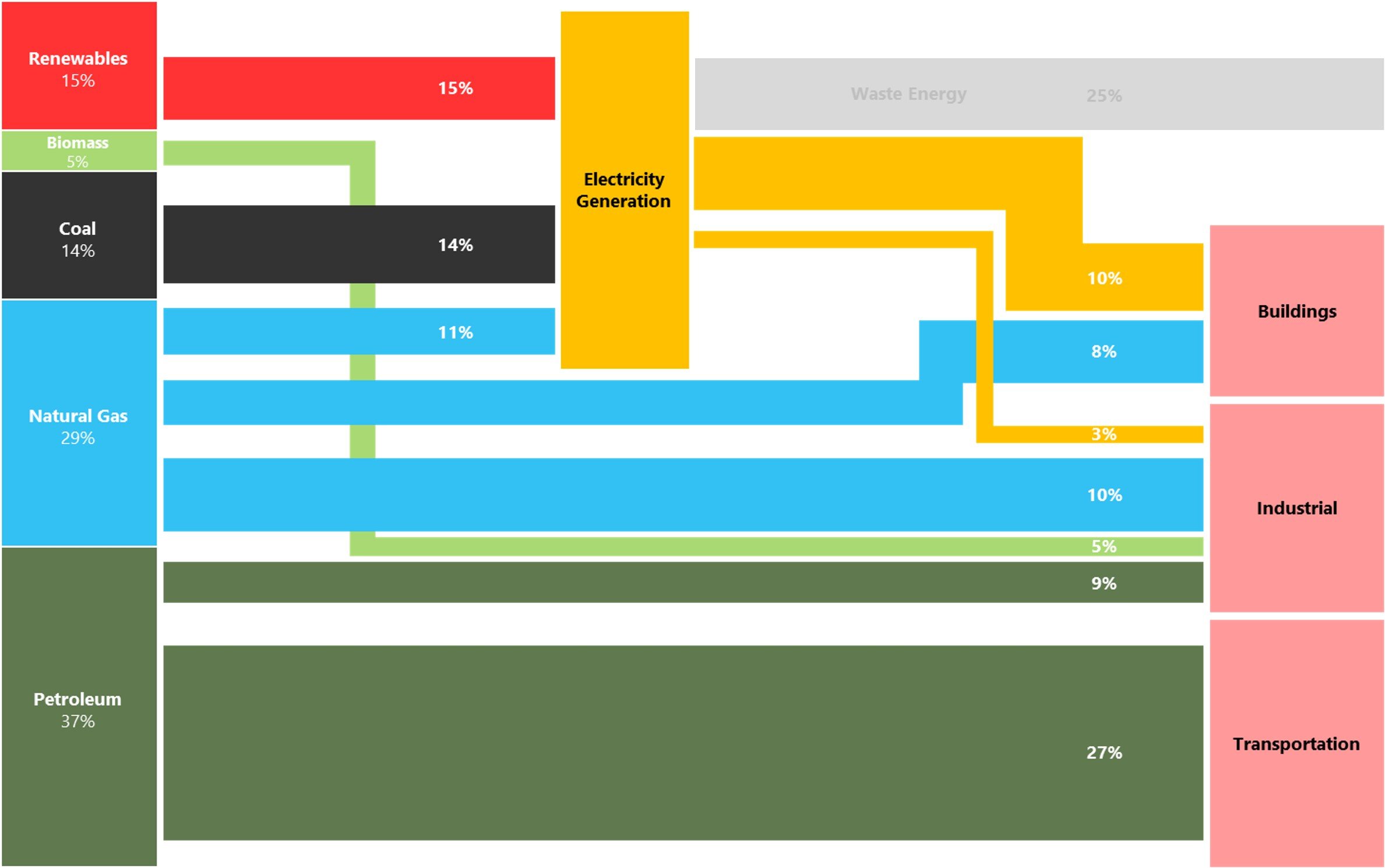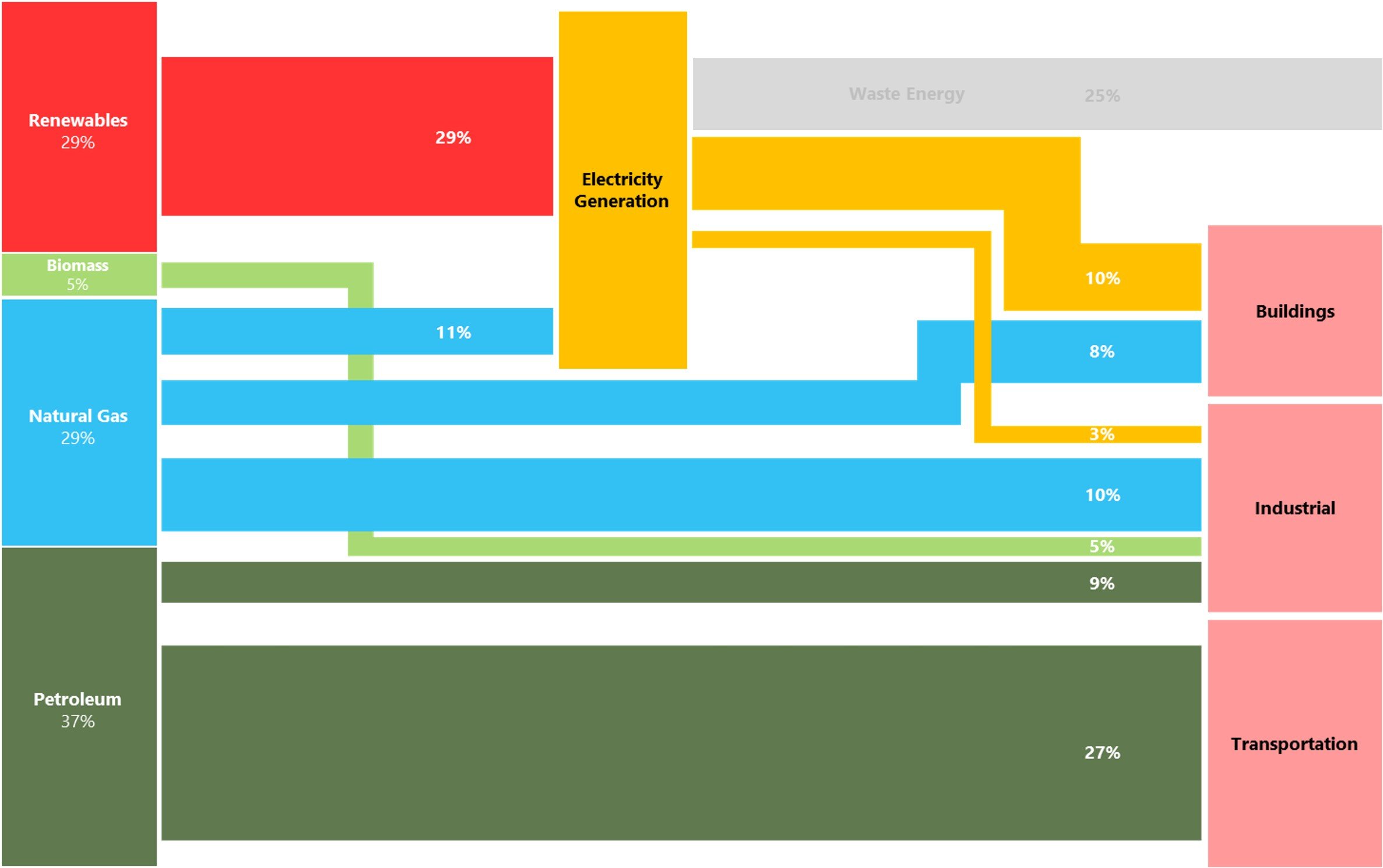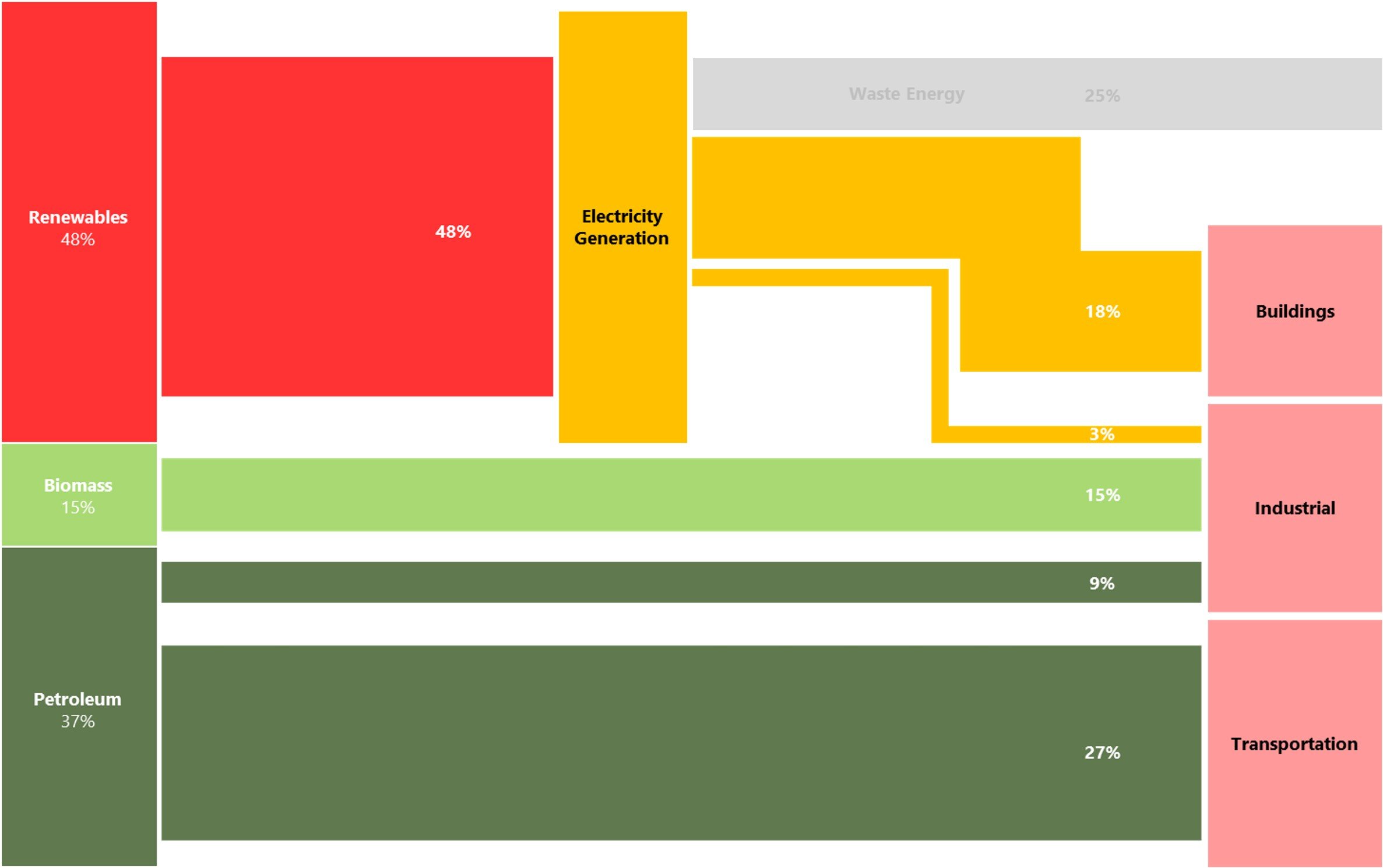Is There Enough Biomass to Fuel the World? Part III
How to divert energy flows from fossil to renewable using electricity and biomass
Summary - Up to 20% of our energy needs could be met by sustainably harvested biomass, in particular food and agricultural waste, as well as manure. Biomass could serve a crucial role in the energy transition by replacing gas and petroleum in (chemical) industry, aviation and maritime shipping.
Definitely Maybe Enough
In part I we determined that the total global land-based biomass production is estimated at 50 billion metric tons per year, which roughly equals 600 TWh of energy per day. In part II we learned that the world needs 435 TWh of energy per day.
That would actually mean enough biomass exists to fuel the world. Or is there?
From left to right, a global overview of the daily energy need, biomass production and an indication of the biomass we can sustainably harvest. The percentages of biomass production and harvest are relative to the daily needs. Check out part I if you like to know more about biomass production and harvest, or part II if you like to know more about energy.
If we only used biomass for our energy consumption, we would need to harvest about 70% of everything that grows on the face of the Earth. On top of that, we would probably need everyone to become vegan in order to free up feed and grazing lands for livestock.
Furthermore, though I do not doubt that we could sustainably harvest 70% of all the forests on Earth, I do not believe that we should. There are better ways to have our biomass work for us. Without having to change anything to our lifestyle, existing biomass supply and ‘waste’ can already provide 20% of our daily energy needs!
The question therefore is not necessarily whether there is enough biomass to fuel the world, but how biomass could fuel the world and what role can it play in the industry transition? In the subsequent sections, I will show you exactly this.
Diverting energy flows from fossil to renewable
How to use biomass to power the world
Let us begin with a simplified flow diagram of energy, also called a Sankey Diagram, of the energy need of the U.S. in 2017. I am assuming the U.S. energy consumption now and not that of the entire world, for the simple reason that it is a bit more comprehensible. The same principles apply however.
Looking at this graph, the challenge becomes tangible. We need to get rid of coal, natural gas and petroleum. These are the black, blue and green energy flows, who need to be changed into red. I make it sound easy, but these bars represent an engineering challenge of immense proportions. I recognize that these flows represent millions of tons of coal, cubic meters of gas, and barrels of oil. Not just a vast amount of resources, an unfathomable amount of money as well.
I also recognize that changing the fossil flows to renewables is the engineering challenge of this century, which is why we should be so excited and honored that we are able to work on this.
A simplified overview of energy flows in the U.S. in 2017. To the left is the total amount of energy produced per source, to the right are the three different sectors in which energy is used. The observant reader will notice the numbers on the right side do not add up. That is ‘correct’, as simplification of the diagram meant leaving a few flows out. Do not worry about those few percent, it is about obtaining overview and simplicity. More elaboration on this can be found in part II of this blog.
Energy Principles - Electrification and Decentralization
Converting the black, blue and green flows into red can be done by means of a simple and limited set of principles. These I have laid out in previous blog(s), including the Energy Transition Principles and Redefining Work. The two principles we need to adhere to are electrification and decentralization.
First, we need to realize that virtually all our energy needs (heating, transport, power) in every sector (buildings, industrial, transportation) can be performed by electricity. In my opinion, everyone claiming we physically need to burn a fuel for any energy purpose is wrong. Sure, it could be the case that it is more economically viable to use chemical energy. From a physical standpoint however, everything that we do and want can be obtained by means of electric power.
Second, decentralization of energy will lead to large efficiency gains because less energy is wasted. To give an example, approximately 58% of all energy produced in the U.S. goes to waste. It is created, only to never be used. So sad. A large part of the waste stems from creating heat in chemical processes and the transportation of energy to the end-user. Coal, natural gas and petroleum are the culprits here: the burning of these fuels tend to lead to inefficiency. A decentralized, mostly electric energy system could dramatically reduce energy waste, and thus energy production.
What then would the role of biomass be? Biomass has enormous potential to serve as a transition-fuel and feedstock, especially for industry, aviation and maritime shipping. It can also serve as seasonal energy storage in the form of wood or energy crops, basically acting as a cheap, self-growing all-organic battery. In due time, scaling of renewables like solar and wind will lead to excess of energy which can be used to create economically viable ‘synthetic fuels’. These are synthesized fuels from renewable feedstocks and can literally be created out of thin air.
Before I dive into these synthetics and the future after biomass however, I will first explain how we can divert energy flows from fossil to renewable for coal, gas and petroleum.
Step 1. Replace coal by woody biomass (short-term) and renewables (long-term)
Coal is primarily used to generate electricity. This is dumb. Burning coal is the most polluting way to generate electricity and probably the best way to quickly destroy the world (global warming, anyone?). This is not the only reason why we should stop using coal asap to generate electricity. According to the International Renewable Energy Agency (IRENA), renewable power is increasingly cheaper than any new electricity capacity based on fossil fuels. At this moment, renewables beat even the cheapest coal competitors on cost. Well before the corona pandemic set in, the coal industry was on life support. We need to pull the plug, cut our losses, and help those who stand to lose their livelihood get new jobs in renewable industries.
As scaling from coal to renewables will take time, woody biomass can play a perfect role to ease the transition. Shutting down coal plants and retraining coal workers will probably take five to ten years. Sustainably harvested wood can be immediately used as a replacement for coal, as then only short-term carbon will enter the atmosphere. It is merely a “climate-change band-aid”, a temporary solution, but it can be done fast.
Renewables take up the part of coal that generate electricity. Biomass could play an important role in the transition in the form of woody biomass.
Step 2. Replace gas by electricity and biogas from manure (short-term) and synthetic gas (long-term)
Gas is used for many purposes: generating electricity, heating buildings, and as feedstock in chemical and other industries. Biomass therefore has a larger role to play when it comes to replacing gas.
Primarily, gas should not be used for generating electricity. Just as in the case of coal, renewables are the cheapest way to generate electricity. Simple as that.
Furthermore, I am a firm believer that all buildings should become fully electric as well. There is currently a big discussion on this in the Netherlands. Not everyone believes gas should be abolished from being used in buildings. One of the arguments by advocates of gas, is that it takes too much energy to warm (old) houses with electricity, especially if they are not well-insulated. In France however, there are plenty of homes which are heated by means of electricity from nuclear plants and the winters are a lot colder there. I personally believe there are plenty of options for even old homes to become fully electric, such as the use of heat pumps or infrared heating panels. I would propose even more than simply removing gas from buildings. What we should strive for, is to transform each building into a miniature renewable power plant. Why? Because, I believe in a decentralized and interdependent energy system. This is cheaper, makes us energy-independent and more resistant to crises. We can fully cover our energy needs and ride out any blackout by covering all our buildings with solar panels and adding a battery for the night. The only thing we would need biomass for in our homes, is to light a cozy fire in our fireplace.
Once buildings are electrified and renewables replace the energy needs that gas previously held, the only sector that will require gas is industry. All the gas we need in the world can be made from, you guessed it, biogas. Primarily biogas made from manure and human waste. Even natural gas companies claim that renewable natural gas captured at sewage treatment plants can provide for our energy needs. For example, gas-industry-backed studies find that renewable natural gas from cow manure has the potential to replace current gas consumption in California by 9 percent, and 14 percent nationwide. This coincides perfectly with our findings, which indicates that biogas from manure and human waste is perfectly suitable and available to replace fossil gas.
The amount of biogas from biomass sources needs to be roughly doubled to satisfy the needs of the industrial sector. Scaling biomass for biogas purposes in the (chemical) industry is therefore required. An example of how this is done in the chemical industry, and how biomass is even completely surpassed by means of synthetic gas, is shown subsequent chapters. Before we explore those options, we need to replace petroleum or crude oil as a source of energy.
Renewables take up the part of gas that generates electricity and energy for buildings, adding another 19% to the renewables mix. Biomass will fulfill the role of gas for industry, made predominantly by manure and upscaling of energy crops.
Step 3. Replace petroleum by biofuels and electrification (short-term) and synthetic gas (long-term)
Petroleum is essentially used for just a single purpose: transport. Almost 80% all the 100 million barrels of oil that we gobble up each day are used in an internal combustion engine. What can replace all these barrels? You guessed it, electrification and biomass.
I believe that land-based transportation will be mostly electric within 10 years. If that is the case, a very sizeable chunk of petroleum would then simply disappear. This will have tremendous implications for the Fossils (the oil and gas industry), as well as the car industry. This could even lead to the infamous carbon crunch scenario, in which the collapse of petroleum-demand triggers a total system collapse in the fossil fuel industry. The collapse of petroleum is not total however.
Aviation and maritime transport will need to remain petroleum based for quite some time. For the next ten years, it is probably in most cases not economically viable to create all-electric sea and air transport. As transforming the maritime industry is my daily work, I can safely state that it will take some time to transform these industries fully. In addition, chemical industry requires petroleum as feedstock to make physical products such as plastics, paint, rubber and even toothpaste. Biomass plays a crucial role in the energy transition for these sectors.
Aviation requires 7.8% of oil consumption worldwide, while maritime shipping accounts for 6.7%. Industry requires about 23% of oil consumption. That means that 37.5% of oil consumption, equaling almost 37.5 million barrels of oil, will need to be derived from sustainable biomass sources.
The final step is to have renewables and biomass replace petroleum. Biomass is perfectly suitable to replace petroleum products in industry, as well as replacing fuel for air- and sea transport. Industry needs about 23 million barrels of oil per day, aviation requires almost 8, and shipping almost 7. Virtually all land-based transport will become electric, which is a whopping 32% of all energy produced. The end result would mean biomass claims roughly 29% of the final energy mix, and renewables the remaining 71%.
A Possible Energy System of the Future
We have done it. All the black, blue and green bars are gone. We saved the world!
Just kidding.
All jokes aside, we do have arrived at a possible energy system of the future in which we rely on renewable sources of energy only. Though it is merely a digital blueprint of one of the possible ways the energy transition might play out, we have a good understanding of the energy flows and the numbers involved. With this blueprint, we can determine the following:
The amount of renewable energy we currently produce needs to be scaled by a factor of 5 for the U.S., but almost 15 times for the world. That is a lot of work, but manageable. We did greater things in our past.
The amount of biomass we produce could already feed 20% our energy needs, which is just 9% shy of our blueprint. Too much biomass is currently wasted however, and it is hard to fully harness the power of already available biomass. Focus should be on collecting manure and agricultural waste, and scaling wood and energy crops while adhering to the ‘food, feed, fiber first’ principle.
Biomass should be dedicated purely to industry, aviation- and maritime shipping. These are the purposes and sectors that require it the most, in which no economically viable alternatives exist for the coming years.
Now that we know how we want the future to look like, there remains but one giant elephant in the room. How on Earth can you ever achieve this?!
I agree on the fact that changing the entire global energy system is quite a challenge. It is not a technical challenge however, but a matter of scaling already existing and matured technologies.
Transition to Biomass for Industry and Transportation
Despite what the oil and gas majors, aka the Fossils, might have told you, biomass is a useful renewable source of feedstock even in energy intensive industries. From a physical standpoint, there is absolutely no reason to use fossil fuels to create all the products we need. Let me show you how all-natural, organic plastic and top-grade biofuel is made.
How biorefineries transform ‘waste’ into all the building blocks of chemical industry
The best example I found on transformation from fossil to biomass in the chemical industry is Chemport Europe. This is an ambitious project aiming to transform the chemical sector in the region of the North-Netherlands to a fully renewable and sustainable industry. With a green energy mix provided by wind turbines, biomass, solar panels and hydropower, plus the opportunities offered by the agricultural hinterland, they aim to grow the ‘Chemical Cluster Delfzijl’ into one of the best biobased locations in Northwest Europe. One of their targets is to use the agricultural waste and grasses from the Northern provinces in the Netherlands as feedstock for the chemical cluster. There are but a few key ingredients involved.
It all starts at the biorefinery, which uses woody biomass from agriculture to refine valuable materials such as sugars to derive plastics. Wind and solar transform the abundance of electricity into gas, also called power-to-gas. Electrolysis is used to create hydrogen and oxygen, changing electricity into gas. Both hydrogen and oxygen are important feedstocks for the chemical industry.
The next step is torrefaction, a process where biomass is converted into biocoal. Instead of waiting millions of years, bio-based coal is created in a matter of hours. This biocoal is consequently fed into a gasification plant, together with lignin, a byproduct from the biorefinery. After this process a rich biogas called syngas is obtained. It is an extremely valuable gas, a mixture of hydrogen, CO and CO2 and forms the basis of thousands of chemical applications.
Syngas can serve as a feedstock for methanol, which in turn can be transformed into ethylene, propylene and butylene. These are the basic building blocks for most chemicals presently derived from oil. It is the green alternative for fossils. They can be used to create toothpaste, paint, rubber, all the necessities that we use everyday. More importantly, syngas can be transformed into bio-LNG and other biofuels for the transportation sector, in particular aviation and maritime shipping. They are the exact same as fossil-derived products, only better.
As you can see, everything that we need can be perfectly made by just plants, or more precisely plant-waste. Those of you who are still not convinced and fear biodiversity issues, I have something even better on offer. What if I told you we can make everything we need, all the chemical feedstocks and fuels in the world, out of thin air?
The Future beyond Biomass: Solar-Synthetic
Given strict requirements, the use of biomass is a perfectly viable and sustainable energy source. Until we have something better. That something is synthetic fuel made out of thin air.
It is my belief that we will use purely synthetic fuels and chemical compounds in the not-too-distant future. A synthetic fuel is a clean fuel that can be made from renewable feedstocks. It is already possible to directly capture CO2 and water from the air and use them to create a synthetic fuel by means of the Fischer-Tropsch process. The end result is a ‘clean’ chemically similar fuel that can be perfectly used for all applications fossil fuels are used for.
That is correct: you can create fuel out of thin air.
Diesel, Naphtha and Paraffin can be directly formed using this technique, which is similar to the one used by Chemport Europe. Instead of using biomass however, in the case of synthetics, carbon is directly taken from the air. There is a downside to this technique though. A tremendous amount of energy is required. You would need your energy source to be costing next to nothing to make this operation economically viable. I have discussed this in one of my previous blogs, the case for floating solar, in which I described an offshore system in which giant floating solar structure would create tremendous amounts of fuel and feedstock for the chemical industry.
Since that time, there have been quite some developments. One example is Heliogen, a company dedicated to creating fuel out of thin air. Coincidentally it received backing by Bill Gates just after I finished writing my blog on a floating version of Heliogen. To me, this is a clear sign that the technology is ready and waiting to be scaled. Will it be twenty years? Will it be two? We can accelerate the timeline if we start working together and investing in these types of companies. It is simply a matter of will.
Coming back to the present, I believe biomass is a transition-fuel until we can economically create synthetic fuels and chemical feedstocks out of thin air.
Rome was not build in a day
But a man was send to the moon in less than 10 years
I sketch future visions that are quite pie-in-the-sky. Creating a blueprint of the energy transition is something I can describe neatly in a few blogs. Reality is messy however, and transforming our energy system is not something that is done overnight.
And yet. To quote Bill Gates: “Most people overestimate what they can do in one year and underestimate what they can do in ten years.” I believe this holds true for the energy transition.
Biomass is a perfectly renewable source of energy and feedstock when adhering to the ‘food, feed fiber first’ principle. It can play a key-role in the energy transition. It is abundant, globally available and best of all: it grows back on its own. It is suitable to replace everything we currently need fossil fuels for, as is already shown by large industrial partners. They truly are nature’s batteries, capturing sunlight and transforming it into sustainable energy.
Everything is in place to create a sustainable world powered by solar energy, biomass and synthetic fuels in the long run. All we need to do is do it.
References & Further Reading
Wikipedia - Biomass
VOX - American energy use
Cleantech - U.S. building sector end use energy consumption
Chemport Europe - Using plant-based feedstock in chemical industry
BusinessWire - Heliogen replacing fuels with sunlight
IRENA - Renewables Increasingly Beat Even Cheapest Coal Competitors on Cost
Los Angeles Times - Cow poop could fuel California’s clean energy future. But not everyone’s on board


